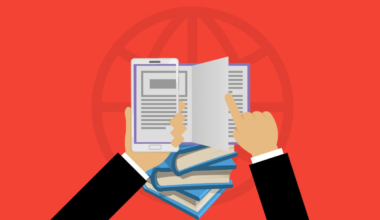6 Tips to Build and Manage a Digital School Library

As students transition further away from physical learning resources and deeper into the online educational realm, digital libraries represent the future of learning for coming generations. There are several reasons for this change, which range from better access to a greater spectrum of choice.
But before we dive into why and how digital libraries can improve student and teacher performance, it would be useful to provide a definition for what a digital library is.
What Is a Digital Library?

A digital library is a collection of resources, such as books, newspaper articles, images, and videos organized in an electronic format and available online in a centralized database. This means that students and teachers can access the resources using Internet-enabled devices such as tablets and laptops. This way of storing educational texts has a wealth of advantages.
Advantages of a Digital Library
- Choice – Digital libraries provide access to a far greater range of content, as they are not confined by the physical space each book takes up. As digital libraries rely on cloud storage, thousands of documents are available without needing to take up space in any building.
- Access – As long as students or teachers have a device that can go online, resources are available anywhere. Students, therefore, do not need to waste time travelling to and from a physical library, and can instead request the desired document from anywhere.
- Retrieval – Finding and retrieving a learning resource when using a digital library is as easy as searching for it using a database, which can take just seconds. This is preferable over the traditional method of walking up and down the corridors of a real library. Incidentally, if you are crafting a cloud-based system, it may pay dividends to know your IaaS, SaaS, PaaS, and more.
- Preventing deterioration – If a source is available online, it means that its physical self does not need to be endlessly handled and moved. This is especially worth considering with particularly rare or precious texts.
Tips to Build and Manage Your Digital School Library
As we can see, digital libraries have the potential to be a powerful way to assist students to find and use educational texts. However, building and maintaining a digital library can have its challenges. Below are six useful tips to making sure that your digital library is as good as it can be.
1. Multiformat

The greater the resource variety of your library, the more chance you have of engaging students. The magic of a digital library is that it doesn’t only support traditional texts such as books and magazines, but is able to contain and display digital formats such as audiobooks and videos.
For some students, reading long articles or large tomes on a subject can prove challenging. They may prefer to learn through listening to an audiobook or via a series of short videos. This means that a more comprehensive selection of students can engage with content and therefore with the learning process.
The online nature of a digital library also means that features to communicate within the library’s software can also be developed. This includes CPaaS meaning capabilities such as sending voice and SMSs could be possible within the library app.
2. Resource Accessibility

Making sure that resources are easy to access for students with a range of learning difficulties can increase the overall impact of your library significantly. Thankfully, digital learning resources are more adaptable to specific learning needs than traditional physical resources.
Digital sources have capabilities such as text-to-speech and font enlargement, as well as a host of highlighting and term-searching software. Utilizing these functions can give students who may have in the past struggled with conventional book learning a better chance of interacting with learning materials.
Online resources can also help students with social disabilities such as autism. This is because online resources can be accessed from home and therefore do not require students with social challenges to enter a difficult environment, such as a busy library. They can instead attend livestreams or download the content they need online.
3. Out-of-Hours Access

One of the main attractions of a digital library is that it is potentially available 24 hours a day. Therefore, giving students a way to access the library even when the physical library may be closed is an easy way to boost engagement.
If staff are unavailable to take inquiries about the digital library in an out-of-hours context, call recording solutions are a good way to make sure no calls are missed.
Either through a personal account or portal software, it is important that both students and teachers can always access the library. This is especially critical for students who have full-time jobs, so that they can structure their learning around their other commitments.
This also means students have the ability to study during the holidays and when they are out of the country. This hopefully results in fewer gaps in knowledge when term time resumes.
4. Do Not Eliminate Your Print Materials

As exciting and useful digital libraries are, they are not infallible and come with their own set of challenges. For example, for whatever reason, the Internet may stop working. So, it is important in those situations that you can employ a backup method of finding resources, like finding the print version of the document you were working with.
To maximize efficiency when it comes to dealing with these types of situations, you might want to invest in a workforce optimization system. That way you can ensure library staff are on hand at times of peak demand, expected or otherwise.
It is also useful to maintain a physical library alongside your digital one, since students, as they progress through their studies, will need to develop research skills suited to both formats.
Ideally, your physical library should work parallel to your digital library. The digital should expand the limits of the physical library, whereas the physical should provide a redundancy option for your most valuable and most-used texts.
5. Content Recommendations
Building the library with a recommendations feature is a useful way of driving further reading and helping students expand their knowledge on subjects.
However, each user of your digital library will be different. They will be using the library to study different subjects, at different levels, and with different aims in mind. This means that content recommendations need to be highly personalized. However, creating a suggestions algorithm is quite an undertaking, so using the best project management software would be advisable.
The algorithm that is written to perform this function must understand each individual well, based on their document choices. Only in this way can the library be relied upon to drive engagement and foster more progressive reading habits.
6. Appealing Content
Lastly but most crucially, the library itself needs to stock appealing and relevant material that is highly suited to all key stakeholders.
It is very easy to get caught up in the excitement of creating a new digital world for students and teachers to explore. However, like with a traditional library, at the end of the day it is the resources themselves that inform and progress learning, not the system by which they are discovered.
With this in mind, it is still incredibly important to curate a range of books and digital resources that cater to the variety of needs of your student body. As mentioned, this should prove easier than curating a physical library due to the increased space and variety available to digital platforms.
Advantages for Educators

With a digital library there comes not only benefits for the students, but for the teachers as well. One of these is the ability to send resource links directly to students so there is no ambiguity about how to access a source. Students can simply click on the link to receive access.
Virtual meetings are also easier with an online library, as sources can be shared as talk continues, so all students are informed as they work through meetings.
In addition, teachers will also receive the same plethora of digital resources as students and therefore can use videos and audio files to teach students. This can open up a deeper level of learning than teaching directly from textbooks.
Requesting and receiving resources should also prove easier with a digital library. Teachers can write a request to the manager of the library, and instead of waiting for a physical copy of the book to arrive, library staff can simply order and download the text in a matter of minutes. This helps teachers remain adaptable and novel because they need not rely on the same textbooks month after month.
Digital resources also tie in better to video conferencing solutions that teachers may ask students to use to encourage collaboration and organizational skills, not to mention general remote learning.
Wrapping Up

By creating your digital library with these tips in mind, you’ll help students become better readers and, ideally, develop greater critical-thinking skills. In addition to the technical proficiencies, the new library should help foster a greater love of reading in students, with more access to the documents they need.